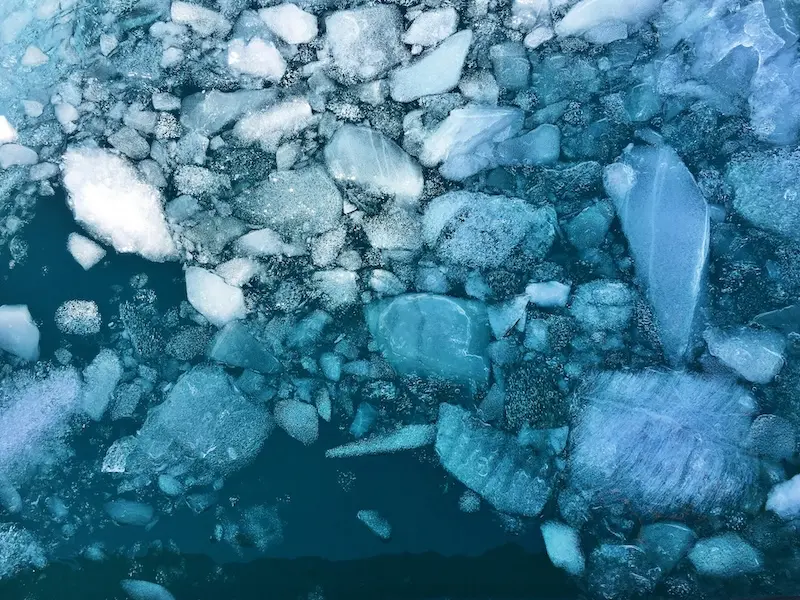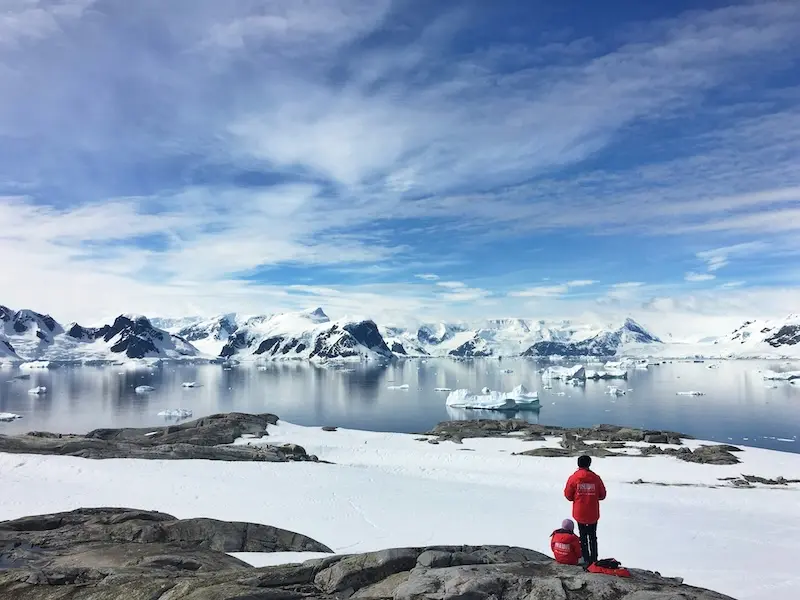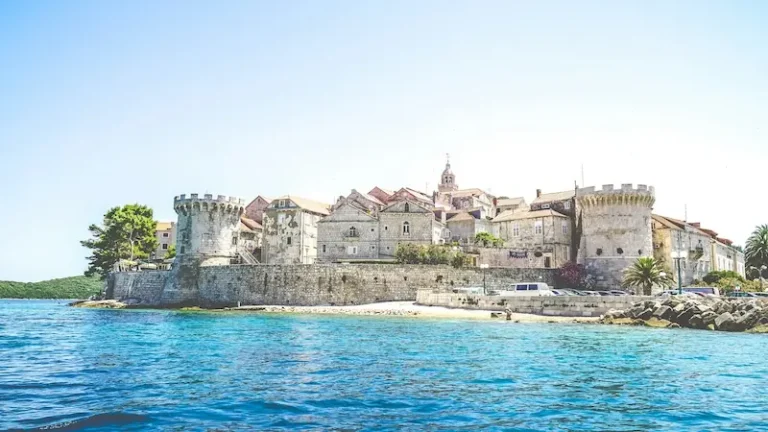ALL YOU NEED TO KNOW TO PREPARE FOR YOUR TRIP TO ANTARCTICA

Envision your ultimate Antarctic expedition – sailing on a luxury expedition vessel, camping beneath the vast polar skies, encountering extraordinary wildlife, diving into frigid waters, kayaking the Southern Ocean, or stepping foot in a research station!
Whether you crave thrills, seek active exploration, or prefer a calmer observation, Antarctica offers myriad experiences tailored to your preferences. Now all you need to do is prepare for your exciting adventure!
Below, check out our list of all the things you need to know to prepare for this incredible trip:
1. How to Get to Antarctica

The two ways to get to this fascinating place are by cruise or plane. Deciding this all depends on a few factors. Is time important to you? if your priority is a swift arrival, a plane is undoubtedly the preferred choice, whisking you to your destination in no time. But, if you want to savour the journey and be amongst the breathtaking vistas, a cruise will promise an unmatched experience and give you that time to soak it all in.
Budget considerations are also something to think about. Cruises may appear more expensive upfront but often include accommodation, light entertainment (not that you will need it with those views) and meals, while flights can sometimes offer cheaper options upfront.
There is something about cruising across the Drake Passage that cannot be beaten, however, this may not be for the faint-hearted! But despite its reputation for rough seas, the Drake Passage offers a unique experience on an Antarctica cruise. As you sail across these legendary waters, you’ll have the opportunity to witness the convergence of the Atlantic and Southern Oceans, creating a dynamic marine environment teeming with life.
Opting to fly rather than cruise across the Drake Passage to Antarctica presents advantages too. Flying eliminates the potential discomfort of those rough seas, and will make it a much more comfortable experience, particularly for those prone to motion sickness. But where is the adventure in that?!
Also Read: 5 BEST PLACES TO SEE IN ANTARCTICA
2. The Best Time to Visit Antarctica

Antarctica’s summer season runs from November to March, when wildlife is most active, days are longer, and the sun is visible 24 hours a day (weather permitting). The warmest month being January.
During the autumn and winter seasons, large portions of Antarctica’s coastline become inaccessible due to the presence of dense ice and plummeting temperatures, which can reach as low as -60 degrees. For travellers, braving these conditions can pose daunting challenges. The biting cold and icy terrain not only makes exploration incredibly tough but also potentially dangerous. Ships struggle to navigate through the dense ice, and the harsh temperatures make outdoor exposure pretty hazardous. An Antarctic adventure during these months is generally discouraged for most people, as it would not only limit the joy of exploring this incredible place but also present significant risks to your safety.
3. What to Pack For Antarctica

Thermal Base Layers: The chilly embrace of Antarctica means thermal layers are a must. They are not just there to keep you nice and cosy, they also help regulate temperature to keep you comfortable as you brave the icy terrain.
Insulated Parka: When it comes to facing the frost, a robust, insulated parka is your armour. An insulated parka will shield you from the biting winds and bone-chilling cold, thanks to its waterproof and windproof shell.
A Base Layer Fleece: The epitome of warmth and comfort. Fleece is incredibly warm and cosy, making it the ideal base layer for chilly Arctic weather. A pullover fleece might even be the better option. Without a zipper running down the front, there’s one less area where cold air can seep in.
Insulated Pants: Step confidently into the frozen landscape with insulated, waterproof pants. Not only do they keep your legs toasty, but they also fend off snow and moisture, ensuring you stay dry and comfortable during your icy break.
Waterproof Boots: Equip yourself with the ultimate Antarctic footwear with insulated, waterproof boots with added sturdy treads. With each step, you will feel the confidence of solid footing. And no one likes cold wet feet right?!
Woollen Socks: Keep your toes toasty with thick woollen socks nestled inside your insulated boots. Your own personal heat generators, ensuring your feet stay warm and dry, no matter how frosty the conditions.
Thermal Gloves: Wrap your hands in the warm embrace of insulated, waterproof gloves. And for an extra dose of warmth, tuck heat packs into your gloves. Heat pads provide instant heat that lasts for hours, ensuring your hands stay nice and warm for long periods.
Woollen Hat: Top off your ensemble with a snug woollen hat or beanie. Locking in precious heat and preventing warmth from escaping through your head. A big woollen hat that covers the ears is even better! Make sure you bring a face mask such as a fleece snood, to help keep you warm and prevent serious wind burn.
Sunglasses: Don’t forget to shield your eyes from the dazzling Antarctic sun with polarised sunglasses. Not only do they provide UV protection, but they also reduce glare, ensuring clear vision as you navigate the glistening expanse of snow and ice.
4. Wildlife in Antarctica

It is important to think about the wildlife you want to see in Antarctica and plan accordingly. Remember, the timing and location of wildlife sightings can vary throughout the Antarctic season and across different regions of the continent. Planning your trip with specific wildlife in mind increases the likelihood of experiencing those unforgettable moments.
Antarctic waters are home to a variety of whale species, including the majestic Blue Whale (although locating one can be difficult due to past hunting), Fin Whale, Humpback Whale, Minke Whale, Orca, and Sperm Whale.
The best time for whale watching in Antarctica is during the austral summer, from November to March. This period coincides with the arrival of large numbers of whales to Antarctic waters to feed on krill and other marine life.
Specifically, locations such as the Gerlache Strait, Paradise Bay, and Wilhelmina Bay are renowned hotspots for encountering whales. Additionally, the South Shetland Islands and the waters around Deception Island provide excellent chances for whale sightings.
Seeing penguins is undeniably one of the most memorable highlights of any journey to Antarctica. This remote continent is home to millions of these charismatic birds, spanning various species such as the majestic Emperor penguins, the lively Adélie penguins, and the charming Gentoo penguins. While your penguin encounters are virtually assured, it’s worth knowing where you’ll likely witness these endearing creatures as they waddle about the icy landscapes.
One of the most iconic spots to witness penguins up close is the Antarctic Peninsula, where colonies of Gentoo, Adélie, and Chinstrap penguins thrive amidst stunning icebergs and rugged landscapes. The South Shetland Islands, located north of the Antarctic Peninsula, are also renowned for their abundant penguin populations, including the opportunity to encounter playful penguins on the beaches of Deception Island.
Although not part of Antarctica, the Falkland Islands and South Georgia Islands are often included in Antarctic cruises and are home to vast colonies of King, Gentoo, and Macaroni penguins. These destinations provide unforgettable experiences for those seeking to witness the beauty and charm of penguins in their environment.
5. Planning Your Trip to Antarctica

Planning your trip to Antarctica well in advance is essential for many reasons. The popular seasons during December and January mean cruises and guided tours get booked up. Booking early increases your chances of securing a spot on your desired trip and itinerary. Antarctica’s tourist season is also brief, typically running from November to March when weather conditions are more favourable. By planning well in advance you can ensure that you visit during this window, maximising your opportunities for optimal weather and wildlife sightings.
Plus, getting all the logistical details sorted like transportation, accommodation, permits, and gear can take time. Planning ahead means you can relax knowing everything’s in place for when you go.
Visiting Antarctica can be pricey, so having time to budget and take advantage of early booking discounts can make a big difference. Don’t forget about all the necessary paperwork and prep either. Planning ahead will mean visas, permits, and any training you may need are sorted out, which means less stress and more time to focus on the excitement of your upcoming adventure.

![BEST CO-WORKING SPACES IN CANGGU [BALI GUIDE]](https://afuncouple.com/wp-content/uploads/2023/07/Best-Co-Working-Spaces-in-Canggu-Bali-768x485.webp)




